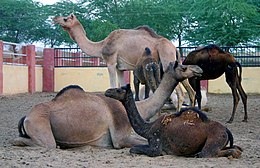This article has multiple issues. Please help improve it or discuss these issues on the talk page. (Learn how and when to remove these messages)
|

ICAR-National Research Centre on Camel, Bikaner, is a Premier Research Centre located at Bikaner city of Rajasthan. Considering the importance of camel in the socio-economic development of arid and semi-arid zones, the Government of India established a Project Directorate on Camel at Bikaner (India) on 5 July 1984 under aegis of Indian Council of Agricultural Research (ICAR) which was upgraded to National Research Centre on Camel (NRCC) on 20 September 1995. It is located in the Jorbeer area of Bikaner city which is about 8 km from Bikaner main city. Mandates of this institute are 1. Basic and applied research for improvement camel health and production; 2. Information repository on camel research and development; and 3. Development of camel eco-tourism. This centre is also known as 'Camel Farm' among the local people. The camel farm maintains an elite herd of more than 300 camels of Bikaneri, Jaisalmeri, Kachchhi and Mewari breeds.
Progress
The key objectives of NRCC are camel breeding and health, utilisation of camel milk and its byproducts like ice-cream made of it, which makes it a one-of-a-kind institute in India. The farm is a complex of camel stables, enclosures, and buildings.
Scientists engage with all stakeholders like camel herders, traders via collaborative programmes for development of camels.
Significant growth had been made on opportunities of camel milk trade in India as a functional food because of its therapeutic health benefits, models of successful camel dairying on cooperative basis, Camel usage by BSF India as this species is found mainly in Rajasthan and Gujarat. Camels have greatly caught the attention of tourists from India and abroad.
In popular culture
Camels are fondly called the "Ships of the Desert" because of their utility in arid climate. They can live without water for many days. They provide alternative means of goods transportation in many districts of Rajasthan, which, in turn, saves fuel and also provides livelihood to many camel herders. The Thar Desert is filled with glorious palaces, natural marvels and, of course, camels which adds to the tourism sector.
Maharaja Ganga Singh of the Bikaner, Rajasthan, India founded Bikaner Camel Corps around 1890 and it participated in World Wars I and II. Because of their long natural history, camels have been declared the state animal of Rajasthan and some communities like Raika are specific in keeping and raising them.
Tourists visiting NRCC and Bikaner enjoy seeing camel calves gamboling around one another during afternoon hours, or camels gathering in sand dunes during sunset. A camel museum is available to apprise them of the developmental and research aspects of the camel in the desert ecosystem. Facilities available are camel riding, desert safari, camel milk and ice cream, kulfi, souvenir shops selling various decorative items like bags, purses, artwork, shawl, small chains, etc.
International Camel Festival is organised in Bikaner, every year on January month (generally second Saturday and adjacent Sunday of January Month). The shows include camel dance, camel race, artwork on various breeds of camels, traditional folk dances by locals.
References
- NRCC (2019). "NRCC Annual Report 2019" (PDF). ICAR-National Research Centre on Camel. Retrieved 22 September 2022.
- "Camel milk, the new Superfood ?". The Times of India. 25 July 2014. Retrieved 28 December 2018.
- "Village women trek to urban areas to sell camel milk". The Express Tribune. 20 December 2018. Retrieved 29 December 2018.
- "Camel milk is full of nutrients and it's growing in popularity". Washington Post. 13 June 2018. Retrieved 29 December 2018.
- "Camel milk is gaining popularity. Could it be an alternative for dairy market?". The Financial Express. 11 November 2018. Retrieved 29 December 2018.
- "National Research Center on Equines". ICAR-NRCE. Retrieved 28 December 2018.
- "eRajasthan Tourism". eRajasthan Tourism. Retrieved 28 December 2018.
- "Camel Ganga Risala of Bikaner". www.lonelyplanet.com. Retrieved 28 December 2018.
- "Rajasthan's nomadic tribe staring at bleak future after CM declares camel state animal". The Times of India. 11 November 2018. Retrieved 29 December 2018.
- Chapman, Roger (18 June 2018). "Tracks in the Sand". Pacific Standard. Retrieved 28 December 2018.
- "Can Camel Milk Save India's Nomadic Raikas?". National Geographic News. 26 October 2016. Archived from the original on 27 October 2016. Retrieved 29 December 2018.
- "'Tourist hut' launched to promote tourism and Camel Husbandry products". krishijagran.com. Retrieved 29 December 2018.
- "International camel festival in Bikaner from January 12". The New Indian Express. 27 December 2018. Retrieved 29 December 2018.
- "Travelling in Rajasthan? Don't miss the Bikaner Camel Festival". Hindustan Times. 14 January 2018. Retrieved 29 December 2018.
External links
- http://www.bikanercamelfestival.com/
- http://camelfestival.com/
- National Research Center on Camel
- Real Bikaner
Categories: